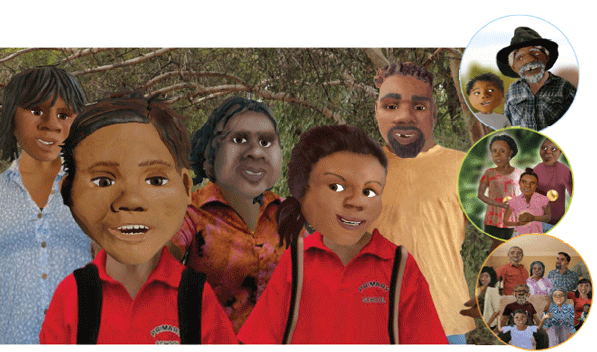The success of 12 animations about the social and emotional wellbeing of Aboriginal families has led KidsMatter to create new user guides to ensure they are used in culturally safe ways.

Last year, KidsMatter released 12 animations designed to help professionals working to support the social and emotional wellbeing of Aboriginal and Torres Strait Islander children and families. The animations provide a rich resource for educators and health professionals and others to use with children, young people, and in schools and community settings.
Key to the success of the animations was the sensitive collaboration between the Central Australian Aboriginal Media Association (CAAMA) who produced the materials and a group of Aboriginal cultural consultants from geographically diverse communities.
The animations were originally intended for families and schools but soon became used more widely, including with children, family and community groups with higher than anticipated demand. Given this broader uptake, it was important to ensure that professionals accessing the material had sufficient understanding of the content of the animations and of how to use them in culturally safe ways. This lead to the development of a series of new film guides that focused on providing context and explanations to support professionals in developing an understanding of the animations, and of how they may best be used in the wider community.
The three film guides, Through your lens, Connecting to heal and Starting Conversations were again produced by CAAMA and have been available online since mid-July with more than 560 downloads to date.
In addition to providing valuable context and information to support professionals using the animations appropriately in the wider community, the new guides have also been successfully used as a professional learning tool to increase knowledge and understanding of Aboriginal and Torres Strait Islander social and emotional wellbeing.
In one of the animations, for example, a key message focuses on the importance of kinship in strengthening Aboriginal children’s resilience. The passing down of knowledge to younger generations operates as a protective factor for young Aboriginal children and is associated with positive social and emotional wellbeing. In this particular animation, kinship is communicated via the central character who talks proudly about the achievements of various family members. The new guides alert professionals to the important role of kinship and of how this is communicated in the animation, and this not only builds professional knowledge but provides a platform for further discussion about how this new understanding can be applied in everyday practise.
Using this kinship message, for example, an early-childhood service might consider how extended family members could be included in the learning program or, in another example, a health service might develop a primary health care approach that incorporates whole families and communities rather than focusing their work on the individual on his or her own.
Another broader application of the animations and associated guides is for organisations to use them as support materials in building Reconciliation action plans (RAPs). A RAP is a plan for an organisation that outlines how an organisation will support reconciliation in Australia and usually involves developing a framework for how the organisation will work towards building respectful relationships and creating opportunities for Aboriginal and Torres Strait Islander peoples. The animations and guides can be used to deepen an organisation's understanding of Aboriginal and Torres Strait islander peoples and thus support increased awareness of the need for reconciliation.
You can find the animations, along with the new guide resources, at kidsmatter.edu.au/atsi-resources
| What is cultural safety? |
| “Cultural safety is about acting in ways that enhance rather than diminish individual and communal cultural identities and empower and promote individual and community wellbeing. To create a culturally-safe space involves a high level of critical reflexivity, as practitioners may not always be aware of how their behaviour and method of interaction could make people from different cultures feel unsafe, with negative consequences for client access and continuity of care”. (Walker. R. & Sonn. C. (2010). Working as a Culturally Competent Mental Health Practitioner In N. Purdie, P. Dudgeon & R. Walker (Eds.) Working Together: Aboriginal and Torres Strait Islander Mental Health and Wellbeing Principles and Practice,. Canberra: Australian Government Department of Health & Ageing.) |